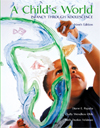Diane E. Papalia,
University of Wisconsin-Madison
Sally Wendkos Olds
Ruth Duskin Feldman
| "still-face" paradigm | research method used to measure mutual regulation in infants 2 to 9 months old.
|
 |
 |
 |
| ambivalent (resistant) attachment | pattern in which an infant becomes anxious before the primary caregiver leaves, is extremely upset during his or her absence, and both seeks and resists contact on his or her return.
|
 |
 |
 |
| attachment | reciprocal, enduring tie between infant and caregiver, each of whom contributes to the quality of the relationship.
|
 |
 |
 |
| autonomy versus shame and doubt | Erikson's second crisis in psychosocial development, in which children achieve a balance between self-determination and control by others.
|
 |
 |
 |
| avoidant attachment | patter in which an infant rarely cries when separated from the primary caregiver and avoids contact upon his or her return.
|
 |
 |
 |
| basic trust versus basic mistrust | Erikson's first crisis in psychosocial development, in which infants develop a sense of the reliability of people and objects in their world.
|
 |
 |
 |
| committed compliance | wholehearted obedience of a parent's orders without reminders or lapses.
|
 |
 |
 |
| conscience | internal standards of behavior, which usually control one's conduct and produce emotional discomfort when violated.
|
 |
 |
 |
| difficult children | children with irritable temperament, irregular biological rhythms, and intense emotional responses.
|
 |
 |
 |
| disorganized-disoriented attachment | pattern in which an infant, after being separated from the primary caregiver, shows contradictory behaviors upon his or her return.
|
 |
 |
 |
| easy children | children with a generally happy temperament, regular biological rhythms, and a readiness to accept new experiences.
|
 |
 |
 |
| emotions | subjective reactions to experience that are associated with physiological and behavioral changes.
|
 |
 |
 |
| gender | signification of being male or female.
|
 |
 |
 |
| gender-typing | socialization process by which children learn appropriate gender roles.
|
 |
 |
 |
| goodness of fit | appropriateness of environmental demands and constraints to a child's temperament.
|
 |
 |
 |
| internalization | process by which children accept societal standards of conduct as their own; fundamental to socialization.
|
 |
 |
 |
| mutual regulation | process by which infant and caregiver communicate emotional states to each other and respond appropriately.
|
 |
 |
 |
| reciprocity | system of mutually binding, mutually responsive relationships into which a child is socialized.
|
 |
 |
 |
| secure attachment | pattern in which an infant cries or protests when the primary caregiver leaves and actively seeks out the caregiver upon his or her return.
|
 |
 |
 |
| self-awareness | realization that one's existence and functioning are separate from those of other people and things.
|
 |
 |
 |
| self-concept | sense of self: descriptive and evaluative mental picture of one's abilities and traits.
|
 |
 |
 |
| self-regulation | child's independent control of behavior to conform t understood social expectations.
|
 |
 |
 |
| separation anxiety | distress shown by an infant when a familiar caregiver leaves.
|
 |
 |
 |
| situational compliance | obedience of a parent's orders only in the presence of prompting or other signs of ongoing parental control.
|
 |
 |
 |
| slow-to-warm-up children | children whose temperament is generally mild but who are hesitant about accepting new experiences.
|
 |
 |
 |
| socialization | develop habits, skills, values, and motives shared by responsible, productive members of a society.
|
 |
 |
 |
| social referencing | understanding an ambiguous situation by seeking out another person's perception of it.
|
 |
 |
 |
| stranger anxiety | wariness of strange people and places, shown by some infants during the second half of the first year.
|
 |
 |
 |
| strange situation | laboratory technique used to study attachment.
|
 |
 |
 |
| temperament | person's characteristic disposition, or style of approaching and reacting to people and situations.
|



 2002 McGraw-Hill Higher Education
2002 McGraw-Hill Higher Education